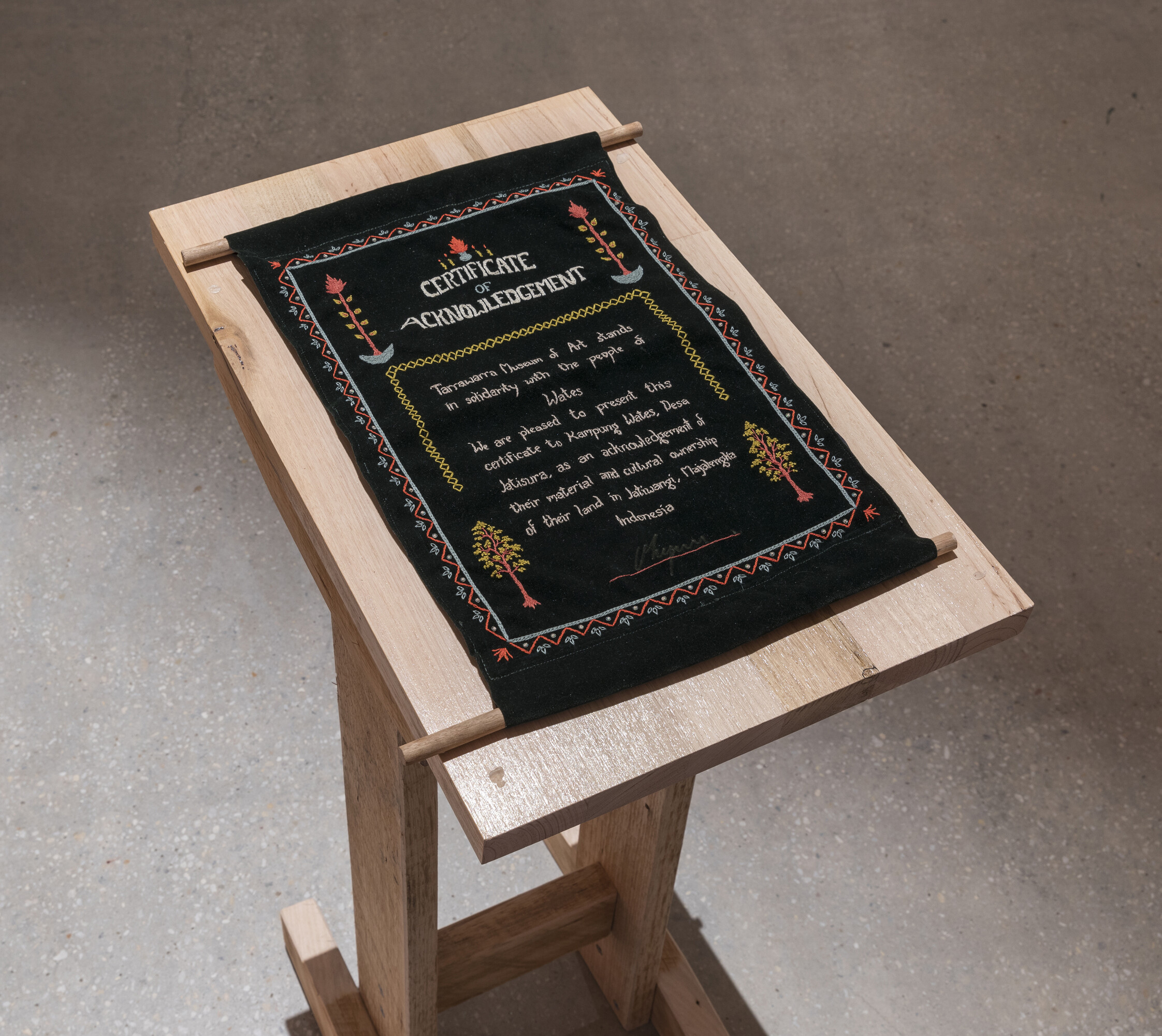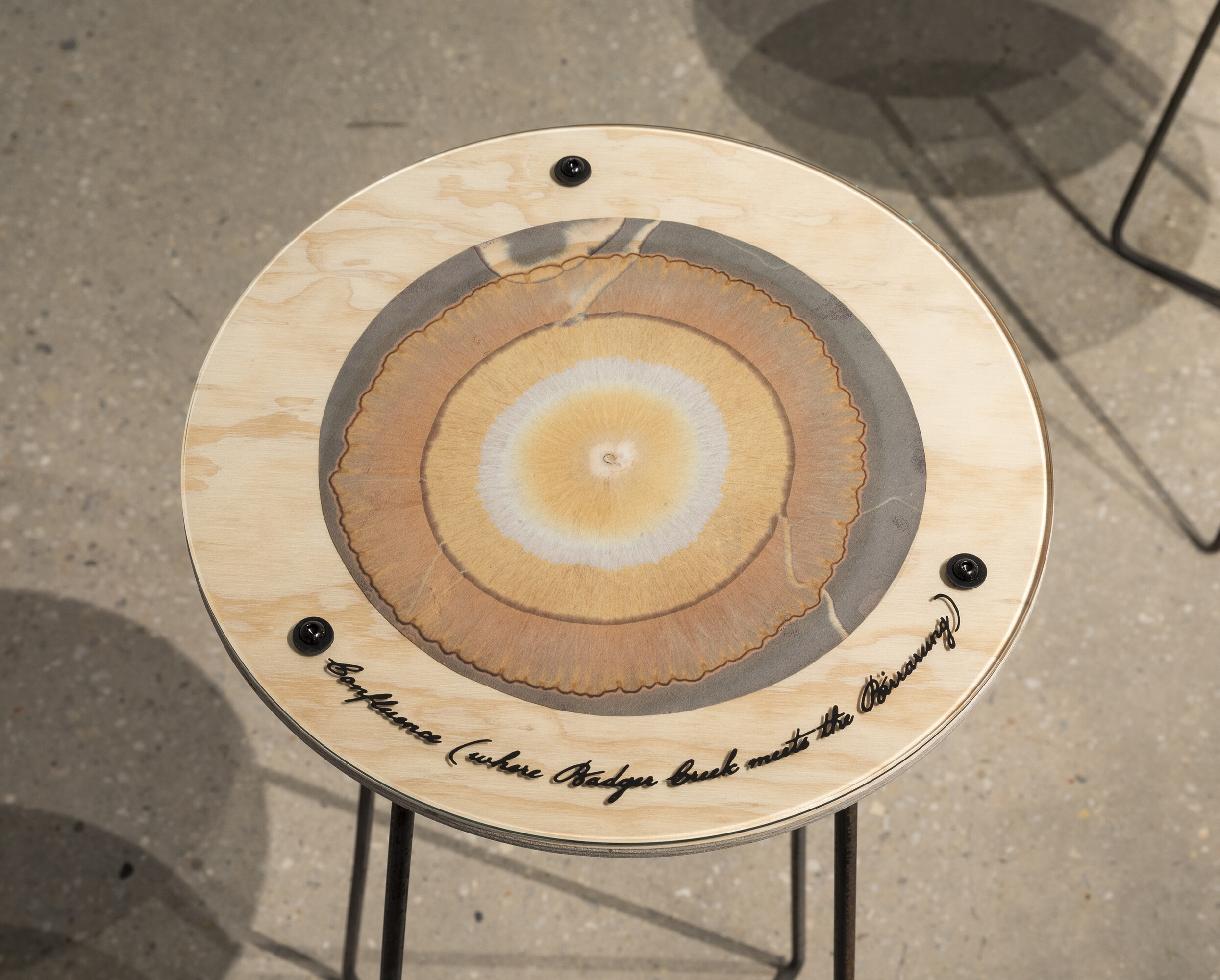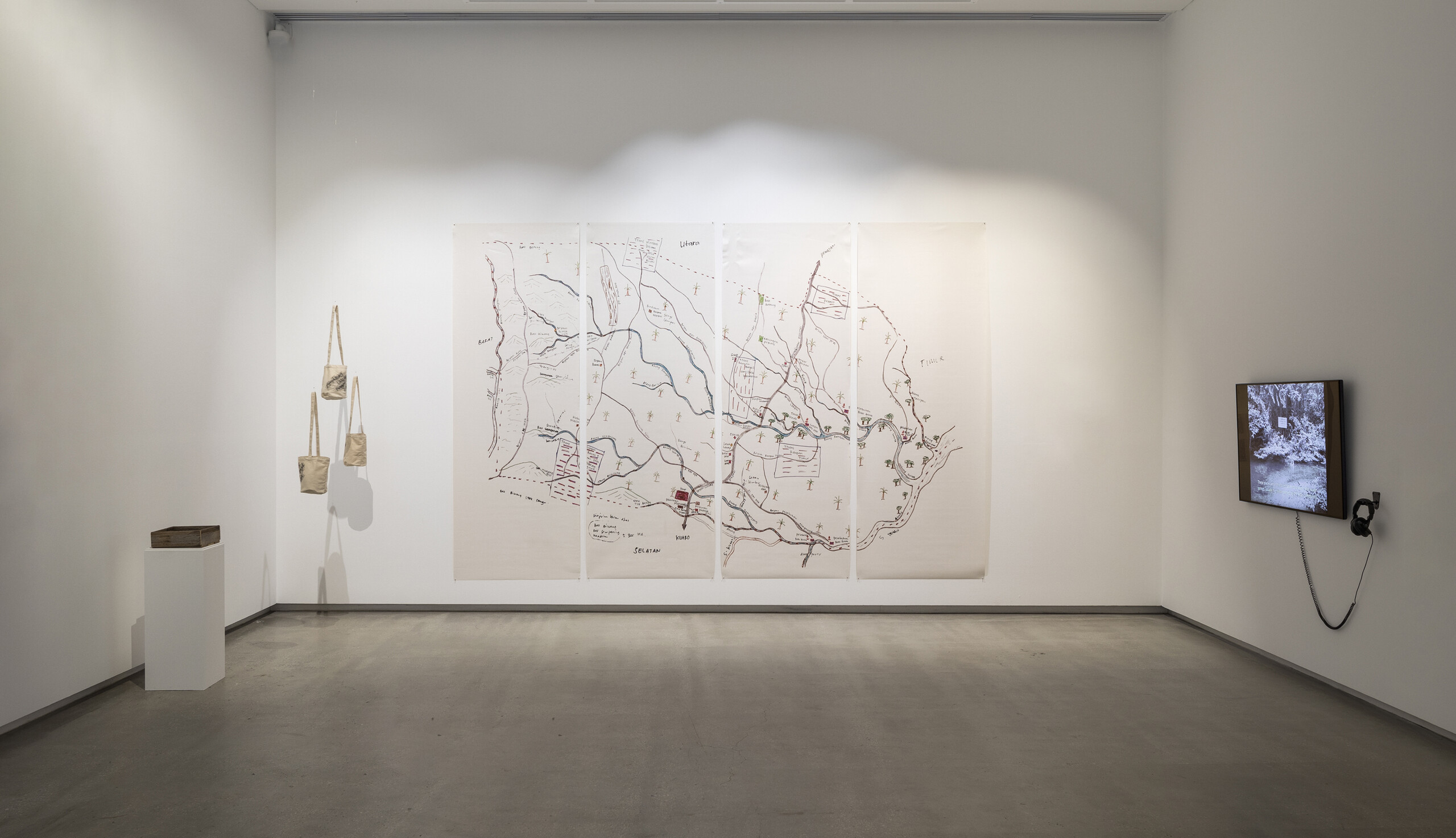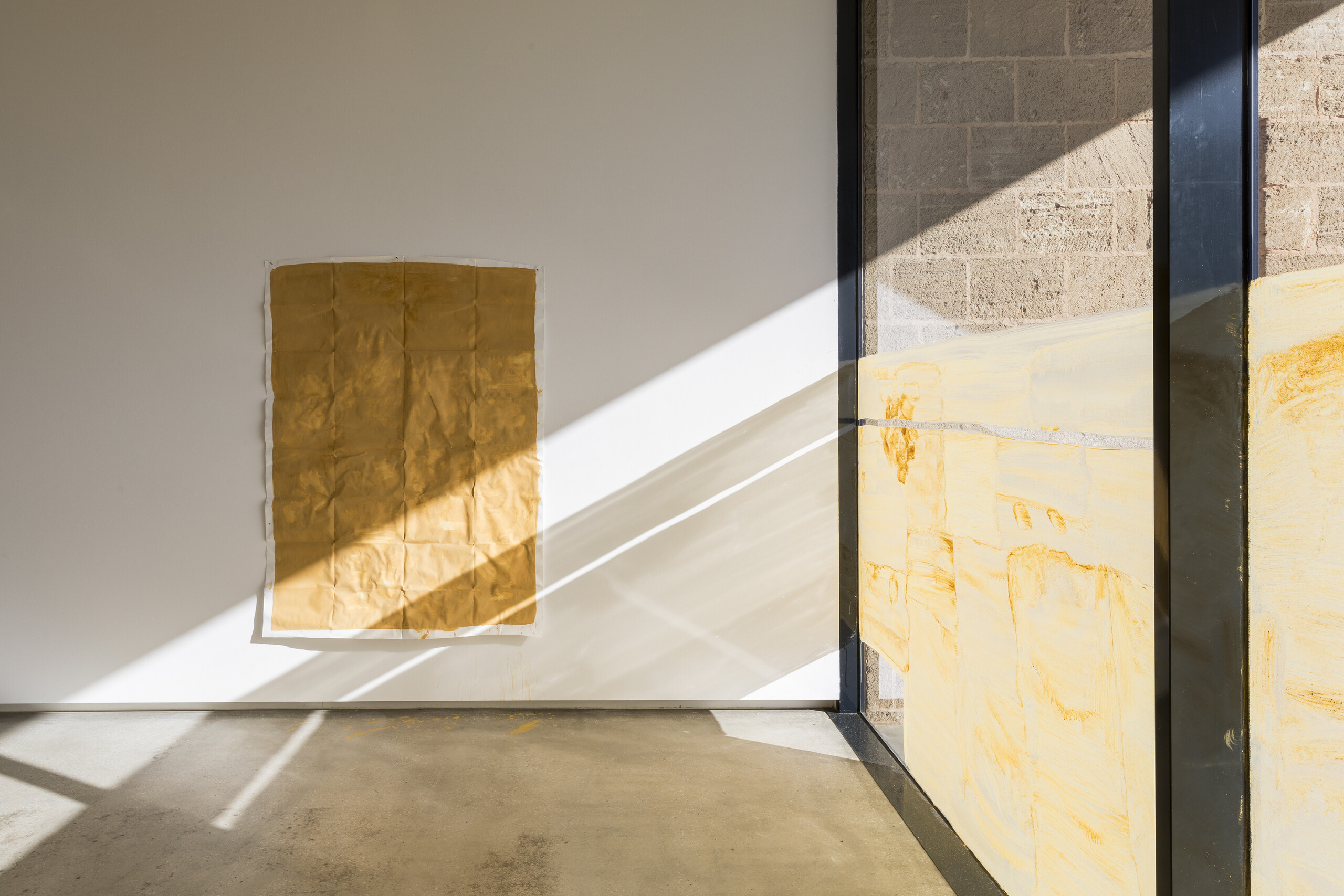The Soils Project
Hilary Thurlow
There are millennia worth of histories sewn into the soil of the site where TarraWarra Museum of Art sits. Yet the history of TarraWarra’s most recent show, The Soils, begins somewhat closer to the present in 2016. The story goes that in 2016 director Victoria Lynn invited Van Abbemuseum (Eindhoven, The Netherlands) director, Charles Esche, who had visited the site many times over a number of years, to propose a project for TarraWarra’s coveted international slot—first instigated by French global-art-biennale-circuit-mainstay Pierre Huyghe’s solo show, curated by art historian Amelia Barikin back in 2015. The English-born, Dutch-dweller, best known for his biennales (São Paulo, Istanbul, etc.) and as a finding committee member for the embattled documenta fifteen, initially proposed a series of closed and private workshops as his project. These were first held on Zoom during the Covid lockdowns, and then held in-person in Healesville. From here, The Soils has morphed into an exhibition charting an expansive cartography, and one that will travel from TarraWarra to Van Abbemuseum (The Netherlands) in 2024 and then to Indonesia where an event will be hosted by Struggles for Sovereignty (Indonesia) in 2025.

As a guest on Wurundjeri Country and working on foreign soil, I should note Lynn has worked tirelessly to build relations and trust with the Traditional Owners, principally the Wandin family and the Coranderrk Aboriginal Station. Lynn’s approach to her practice as a director can be best understood by an artwork that sits across the seven boundaries of Coranderrk, when the reserve was at its largest in 1866 at some 4,850 acres: untitled (seven monuments) (2013/4–2019), a project by Aunty Joy Murphy Wandin (Wurundjeri), Jonathan Jones (Wiradjuri/Kamilaroi), and Tom Nicholson (Celtic-Australian). The kind of relation building in untitled (seven monuments) is replicated in The Soils with its extensive contingent of participants and curatorium of advisors:
Uncle Dave Wandin (Wurundjeri) and Brooke Wandin (Wurundjeri), Wandoon Estate Aboriginal Corporation; Peta Clancy (Bangerang); Megan Cope (Quandamooka) and Keg de Souza; D Harding (Bidjara, Ghungalu and Garingbal); Badan Kajian Pertanahan (Bunga Siagian & Ismal Muntaha); Beyond Walls (Armando Ello, Jeremy Flohr, Glenda Pattipeilohy, Suzanne Rastovac); Wapke Feenstra; Lian Gogali and the Insitut Mosintuwu; Moelyono; Pluriversity weavers: Seynawiku Izquierdo Torres, Dwasimney Del Carmen Izquierdo Torres, Dwanimako Arroyo Izquierdo, María Eufemia Arroyo Izquierdo (Kwarte Umuke community, Sierra Nevada de Santa Marta, Colombia), Ana Bravo Pérez, Aldo Ramos, Aliki van der Kruijs, LI Yuchen; Riar Rizaldi; Yurni Sadariah (member of PEREMPUAN AMAN of Rangan Adat communities); Diewke van den Heuvel; Rolando Vázquez; and the Advisors: Wandoon Estate Aboriginal Corporation, Zena Cumpston (Barkandji), Antariksa, Dr Danny Butt, Dr Helen Hughes, Rolando Vázquez.
Soil is universal. It grows our food and quite literally grounds our feet wherever we are. Yet these links between so-called Australia to Indonesia and The Netherlands are strange. On a meta level, all three sites have different but related histories of colonisation: Australia, a settler-colony, colonised by Britain; the Dutch colonised numerous places, including Indonesia (finally leaving, post-Japanese occupation in 1962) and Surinam; and Indonesia both was colonised by the Netherlands and has colonised areas of West Papua. The modes of colonisation aside, it’s an odd cartography to chart. The Dutch occupation of Indonesia from the 1600s had more industrious ambitions than Australia’s initial penal settlement, but it’s not necessarily all that useful to go tit-for-tat and compare colonial missteps, aside from noting their differences. The connections between the three localities triangulated are opaque. Australia + Indonesia = colonies, albeit different, and geographical neighbours. Indonesia + the Netherlands = colonised and coloniser. Australia + The Netherlands = I’m not too sure. Although The Netherlands’ cultural attaché to Australia made known the desire for strengthened (soft) diplomatic ties in the exhibition’s opening speeches. Alternatively, while it’s not immediately obvious why these strange territories should be brought into relation, there is something clearly useful about thinking their different histories of both colonisation and sovereign resistance together. Here, comparative global colonial histories are built instead of siloed national histories; ideally, this may lead to the formation of transnational solidarity networks amongst the artists, researchers, and activists involved in The Soils Project.
As part of the opening celebrations, Bandan Kajian Pertanahan’s (BKP) Cultural Acknowledgement of Land Ownership #1 (2023)—a brightly embroidered regal-looking certificate made from canvas—was signed by Lynn on behalf of TarraWarra to acknowledge the land upon which the exhibition is situated and as a symbol of acknowledgement of cultural ownership. The certificate will be returned to Wakare Museum, a community site developed by the collective in Wates, Jatiwangi. In addition to the certificate, there’s an acrylic three-dimensional triangle filled with soil from Wandoon Estate Aboriginal Corporation to signal reciprocal solidarity in the ongoing struggles for acknowledgement of land ownership.

Commentary on the physicality of soil and its relation to place is carried through to Megan Cope (Quandamooka) and Keg de Souza’s Soil Stories of Coranderrk (2023). At first glance the eleven maps look a bit like kitchen stools with the top of the “seat” reading as the cross-sections of tree-trunks. Upon closer examination, however, these rings map soil chromatography with material taken from local sites. Each site is accompanied by neat cursive—the kind that conjures imagery of letters written by early settlers directed to Empire and detailing their exploits and melancholy in newfound lands—detailing the locations of the soil. The collaborative process beneath the work also hints at a “two-ways” approach to mutual learning between Aboriginal and non-Aboriginal artists working collaboratively.
Yurni Sadariah’s Rangan Territories Map (2023) continues the thread of alternate cartographies. Drawn by the Paser “Adat” Indigenous community in 2017, the work charts lost indigenous territories that have slowly disappeared since the 1970s because of environmental offences—aided by the Indonesian government transmigration program in 1984 to force peoples off their Javanese land and onto other islands. Notably all the text on the map is translated from Bahasa Indonesian into English. Taking a different tact to language, Brooke Wandin’s (Wurundjeri) biiknganjinu ngarbgudji (2023) is a conversation about Country between Wandin’s family members who are sharing in Woiwurrung without English translation. I don’t have access to this work, and nor should I as someone who has no ties to this place aside from being an uninvited visitor. This is not about accessibility but is instead about preservation.

Although the exhibition is collaborative by its definition, I would argue the lynchpin rests upon Esche’s—a self-proclaimed white heterosexual male—definition of the term “decolonisation.” Calls for decolonisation are everywhere. From education to political science to STEM to the arts and even tourism, the term has become ubiquitous, but what does it mean? How does it function? Can its definition ever be universal? A quick search of e-flux’s announcements demonstrates the term’s usage is on the rise, as the “post-colonial” falls out of favour. Unangax̂ scholar and pedagogue Eve Tuck has noted her surprise that these terms have been taken up so widely in the arts, even referring to “fan art” produced in reference to her essay “Decolonisation Is not a Metaphor” (2012), written with fellow scholar, K. Wayne Yang.
For Esche, the practice of decoloniality is rooted in the practice of history: revisiting and processing the past to heal futures unknown. This definition is deeply rooted in the thinking of Argentinian thinker Walter Mignolo’s ideas of modernity, which are bound to colonialism’s episteme and draw on South American case studies. Yet the act of decolonising must be defined by the site of the colony and its relational minutia; universal, globally transmitted definitions are fruitless. Rooting decoloniality in history gives way to the present-day complexities of living in a settler-colony; “post-colonial” signals an endpoint; while reconciliation asserts there’s a pre-relationship that has fallen apart and can, or should, be reconciled. The future will never change while so-called Australia’s colonialism is an omnipresent force without a foreseeable end as extraction in all its forms continues. As Lenin has told us, capitalism is the highest form of imperialism.

Speaking to culture’s ability to move, D Harding’s (Bidjara, Ghungalu, and Garingbal) As I remember it (The Soils Project) (2023) takes the form of layers of diaphanous liquid pigment made from locally sourced earth and gum acacia painted across walls, windows, and sheets of creased heavy paper. The pigment’s colour moves from a yellow-like colour similar in tone to that you see passing through clouds at twilight. You could think of the substance as almost akin to a thirteenth-century tempera. Harding has carefully consulted with the Wandin family on how best to utilise materials from a Country that is not the artist’s own. On the windows located at the northern side of the gallery, a thin linear plane of glass is sandwiched between the applied pigments, drawing an acute awareness to one’s body and its surroundings. I’m made immediately aware of my height, not quite being able to see through the glass pane without standing on my tippytoes. The paper, the walls, and the windows carry with them an ephemeral quality, their own temporal framework. As I remember it forms a larger project for D with iterations shown in Meanjin/Brisbane (in collaboration with their cousin Hayley Williams), Lisson Gallery, England, and Bergen Kunsthall, Norway.
The work of decolonising isn’t in the language itself but is, in part, relation-building, as Lynn and Esche have both long committed themselves to. Esche has spent his years at Van Abbemuseum building relations to work through the history and capital tied up in the institution and regularly attempts to refer programming back to this struggle, just as Lynn has spent years building relations in her role at TarraWarra. Relations have been built amongst the participants of the project (through countless workshops, meetings, Zooms), and while this relationality is not immediately visible in the exhibition, it nonetheless undergirds it.
There’s a kind of hybridity built within this Indigenous-settler relation building. Perhaps the hybridity I’m trying to define is better articulated by the practices and in the works. Language and its many meanings seems to only take us in circles and lead us to complex paradoxes. Much of The Soils Project’s potency is arguably in the conversations had and the solidarities built, which, as mentioned, are largely invisible within the exhibition itself. This isn’t necessarily good or bad. It’s kind of like reading the minutes from a meeting you weren’t at. You have some puzzle pieces, but not enough to see the full image. Perhaps there’s a lesson to be learned in this: to not have access to every piece of knowledge is an uncomfortable place to be, but ultimately not all knowledge is ours to hold.
Hilary Thurlow is a PhD candidate in Art History and Theory at Monash University, Naarm/Melbourne. She is currently residing in Chicago, Illinois as a Fulbright Scholar.


